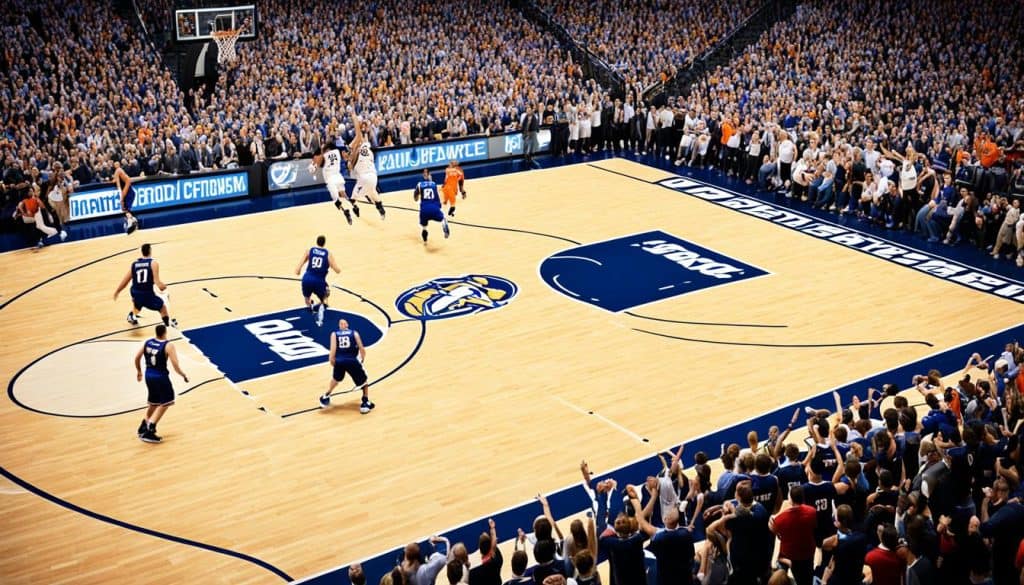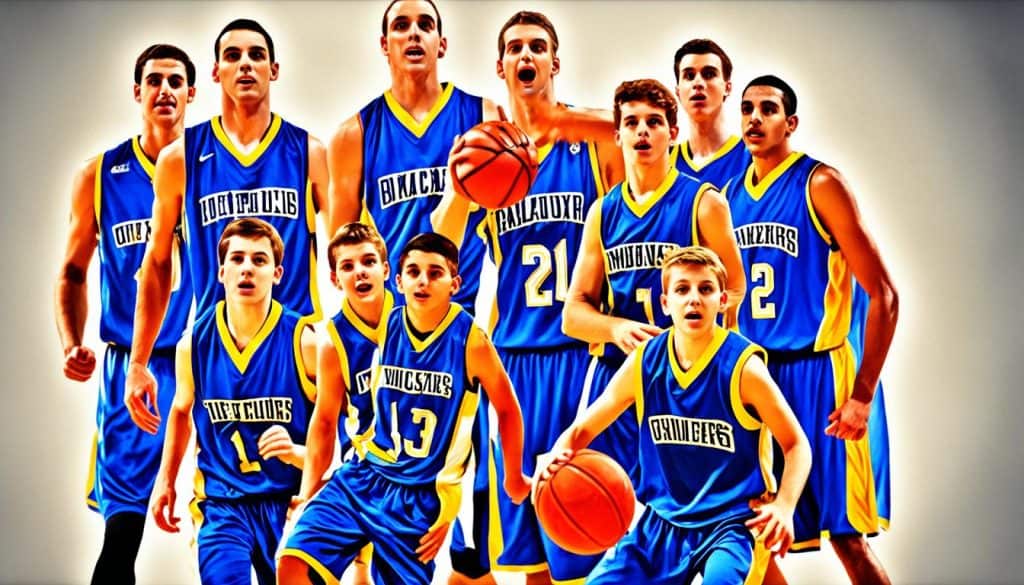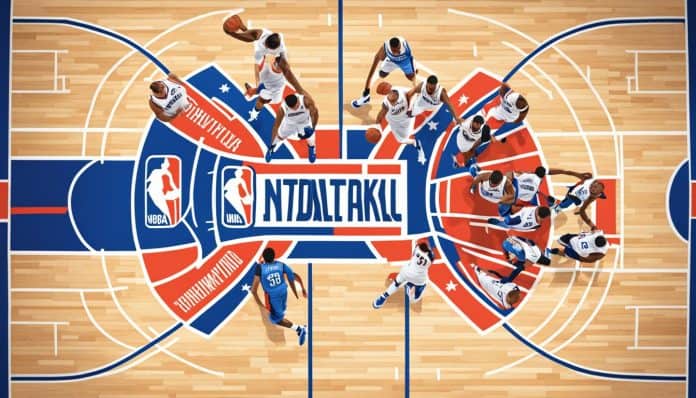If you love basketball or dream of coaching, knowing the best team size is key. It changes based on where you play. For example, in the NBA, college, or with youth, the number of players can really change the game.
Figuring out the best basketball team size is quite complex. It depends on many things, like coaching style and the league’s rules. The NBA has its own way, with set team sizes. College, international leagues, and youth teams work a bit differently to fit their needs.
Key Takeaways
- The best team size changes with the level you play at.
- In the NBA, teams have about 15 players to balance skills.
- College teams adjust their size according to NCAA and scholarship rules.
- Youth teams focus on including everyone and growing their talents, allowing for different team sizes.
- International teams follow FIBA’s lead, usually sticking to 12 to 15 players.
Understanding Team Composition in Professional Basketball
In the high-stakes world of professional basketball, team setup is key. NBA teams carefully choose players to play well and be adaptable. This practice helps them perform their best and play smart throughout the season.
NBA Roster Standards and Rotation Strategies
NBA teams have 15 players on their roster, including both active and inactive players. However, only 13 can play in the games. Coaches carefully manage player rotations to win more games and adjust to different situations. This strategy keeps teams strong and able to face any opponent during the season.
The Role of Bench Players in Professional Basketball
Bench players aren’t just backups; they play a vital role. They keep the team sharp and ready, adding new energy and skills when they get to play. Having strong bench players shows a team’s ability to handle tough times and still do well. NBA bench players help keep the game going smoothly and sometimes surprise the other team, changing the game’s direction.
| Player Role | Importance in Team Dynamics | Contribution Examples |
|---|---|---|
| Active Players | Core performance and scoring | Starting lineup contributions, major minutes |
| Inactive Players | Strategic reserves and recovery | Available for unforeseen circumstances or injuries |
| Bench Players | Tactical flexibility, energy injection | Specialist skills, rest periods for starters, momentum shifts |
A strong team with the right players and strategies can go far in the NBA. By using their bench power wisely, teams are better prepared to face challenges and work towards winning a championship.
The Dynamics of NCAA Basketball Team Sizes
College basketball is special because it follows NCAA laws. These rules touch everything from who’s on the team to who can play. Knowing how many players are on men’s and women’s Division I teams helps us see how college sports work.

NCAA Scholarships and Structure
In college basketball, the NCAA sets special rules about scholarships. Men’s Division I teams can give out 13, while women’s teams can have 15. This shows the NCAA is working to make things fair by making sure each team is packed with talented players.
Bench Depth: The Role of Walk-Ons
Big stars aren’t the only ones who matter on college basketball teams. Non-scholarship players, or walk-ons, are key too. They help make the bench stronger. Through hard work, they can even get the chance to play. Walk-ons make teams better and keep the game competitive.
- Number of Scholarship Players: Controls team core capabilities and strategic depth
- Role of Walk-ons: Enhances team dynamics and competitive spirit
The NCAA’s scholarship rules and the chance for walk-ons create a special world for NCAA basketball. It’s all about finding the right mix of players for a team.
How Many People on a Basketball Team: Youth and Amateur Leagues
In the dynamic world of youth and amateur basketball, the team size is key. It shapes the welcoming and growing area that these leagues are known for. Unlike pro leagues, these youth and amateur leagues adjust the team size and composition. This is to meet many needs and create chances for all. It helps players grow their skills and love the game.
Flexibility in Team Size and Composition
In youth basketball, team sizes vary to fit different needs. Small teams focus more on each player, helping them improve. Larger teams offer more chances to play, making sure everyone can join in. This flexibility lets teams work in different ways, aiming to reach the main goals of youth basketball.
Developmental Goals and Inclusivity
The main aim in these leagues is to make a community where everyone can improve. It relies on having a mix of player abilities, not just the numbers. This mix supports loving the game and learning to be a good sport. Coaches and organizers teach about skills, teamwork, and sportsmanship. This matches the wider lessons that sports can bring.

| Team Size | Focus | Benefits |
|---|---|---|
| Small (5-8 players) | Individual Skills | Increased personalized coaching, faster skill acquisition |
| Medium (9-12 players) | Team Dynamics | Balance of personal attention and team cohesion |
| Large (13+ players) | Inclusivity | More playing opportunities, diverse playing styles |
Looking into the size and composition of youth and amateur teams shows their core values. These include opening the game to all, building skills, and loving basketball. By making teams to meet the goals of youth basketball, coaches and leaders help kids grow both in sports and in life.
International and Olympic Basketball Team Formations
In the world of sports, few matches are as thrilling as the Olympic and international basketball games. Teams follow FIBA’s rules, which means they have 12 to 15 players. This rule helps keep the games fair and shows off talent from all over the world.
FIBA Guidelines and International Competition
FIBA’s rules are key for international basketball games. They set the roster size to make sure teams work well together. Following these rules is crucial to keep the games fair and exciting. Doing well in the Olympics and other big games means following FIBA’s guidelines well.
Iconic International Teams and Olympic Basketball
Some international teams have made a big impact in basketball history. The Olympics highlight this, letting players from around the world compete. They play not just for victory but also to celebrate sportsmanship and unity. The Olympics show how organizing teams well leads to memorable games and moments.
























































